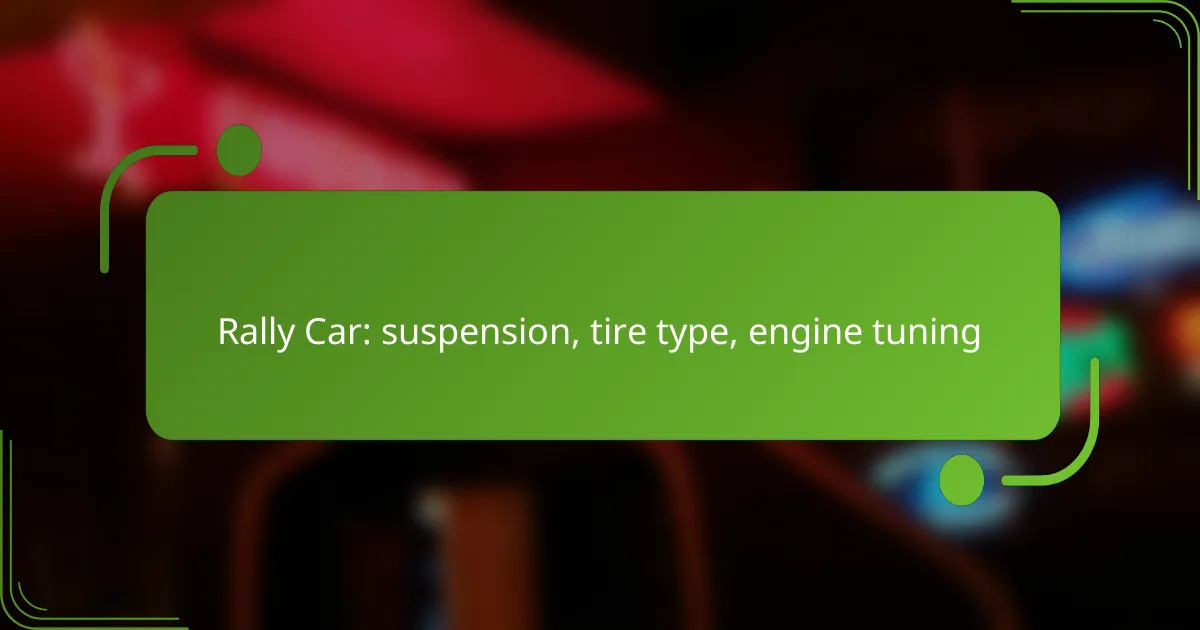Rally cars require specialized setups to excel in diverse terrains, with suspension systems like adjustable coilovers and multi-link configurations playing a crucial role in performance. The choice of tire type is equally important, as it directly impacts grip and handling on varying surfaces. Additionally, effective engine tuning techniques, such as ECU remapping and turbocharger upgrades, are essential for maximizing power and reliability in demanding rally conditions.

What are the best suspension setups for rally cars in Canada?
The best suspension setups for rally cars in Canada typically include adjustable coilovers, MacPherson strut systems, multi-link suspension, and air suspension systems. Each option offers unique advantages depending on the terrain and driving style, making it essential to choose the right setup for optimal performance.
Adjustable coilovers
Adjustable coilovers are a popular choice for rally cars due to their versatility. They allow drivers to modify ride height and damping settings, which can significantly affect handling and comfort on various surfaces, from gravel to snow.
When selecting coilovers, consider the range of adjustment available. A good set should offer at least a few centimeters of height adjustment and multiple damping settings to fine-tune the suspension for specific rally conditions.
MacPherson strut systems
MacPherson strut systems are commonly used in rally cars for their simplicity and lightweight design. This setup provides a good balance between performance and cost, making it accessible for many rally enthusiasts.
While MacPherson struts are effective, they may not offer the same level of adjustability as coilovers. However, they can still be tuned with different spring rates and dampers to improve handling on various terrains.
Multi-link suspension
Multi-link suspension systems provide superior handling and stability, especially on uneven surfaces. This design allows for better wheel control and can adapt to the changing dynamics of rally driving.
Though more complex and often heavier than other systems, multi-link setups can be highly beneficial for competitive rally cars that demand precision. Consider this option if you prioritize performance over simplicity.
Air suspension systems
Air suspension systems offer the ability to adjust ride height on-the-fly, which is advantageous in rallying where terrain can vary dramatically. This flexibility allows drivers to optimize their vehicle’s stance for different stages of a rally.
However, air suspension can be more prone to failure compared to traditional setups and may require more maintenance. Ensure that the system is robust enough for the rigors of rally driving if you choose this option.
Spring rates and damping adjustments
Choosing the right spring rates and damping adjustments is crucial for achieving the desired performance in rally cars. Stiffer springs can improve handling on smooth surfaces, while softer springs are better suited for rough terrains.
When tuning your suspension, aim for a balance that allows for both comfort and control. Regularly test and adjust these settings based on your driving experiences to find the optimal setup for your specific rally conditions.

How do tire types affect rally car performance?
Tire types significantly influence rally car performance by affecting grip, handling, and overall traction on various surfaces. Choosing the right tire for the conditions can enhance speed and control, while the wrong choice can lead to poor performance and increased risk of accidents.
All-terrain tires
All-terrain tires are designed to perform well on a variety of surfaces, including gravel, dirt, and tarmac. They typically feature a tread pattern that balances off-road capability with on-road performance, making them versatile for mixed rally stages.
When using all-terrain tires, consider the specific conditions of the rally. They are ideal for events that transition between different terrains, offering a compromise between grip and durability.
Soft compound tires
Soft compound tires provide maximum grip on surfaces like gravel and mud due to their flexible rubber composition. This type of tire heats up quickly, enhancing traction but also wearing out faster, making them suitable for shorter stages.
For optimal performance, use soft compound tires in warmer conditions or on stages with loose surfaces. However, be mindful of their lifespan and plan tire changes accordingly during longer events.
Studded tires for winter conditions
Studded tires are essential for rallying in icy or snowy conditions, as they feature metal studs that dig into the ice for improved traction. These tires are specifically designed to handle extreme winter weather, providing stability and control.
When selecting studded tires, ensure they comply with local regulations regarding tire use in winter conditions. They are best used in temperatures below freezing, where their performance can be maximized.
Rally slicks for dry surfaces
Rally slicks are optimized for dry, smooth surfaces and offer the best grip due to their lack of tread. This type of tire is ideal for asphalt stages where maximum contact with the ground is crucial for speed and handling.
Using rally slicks requires careful attention to weather conditions; they should only be used when the surface is completely dry to avoid losing grip. Regularly check tire temperature and pressure to maintain optimal performance.
Tire pressure adjustments
Adjusting tire pressure is crucial for maximizing performance in rally conditions. Lowering tire pressure increases the contact patch, enhancing grip on loose surfaces, while higher pressure can improve responsiveness on hard-packed roads.
A common practice is to start with a baseline pressure and adjust based on the surface and weather conditions. Regularly monitor tire pressure throughout the rally to adapt to changing conditions and maintain optimal performance.

What are effective engine tuning methods for rally cars?
Effective engine tuning methods for rally cars focus on enhancing performance, responsiveness, and reliability under extreme conditions. Key techniques include ECU remapping, turbocharger upgrades, exhaust system modifications, cold air intakes, and fuel system enhancements.
ECU remapping
ECU remapping involves reprogramming the car’s engine control unit to optimize fuel delivery and ignition timing. This can lead to significant power increases, often ranging from 10-30% depending on the vehicle and modifications. It is crucial to ensure that the remap is tailored to the specific rally conditions and fuel quality.
When considering ECU remapping, choose a reputable tuner familiar with rally specifications. Avoid generic maps, as they may not account for the unique demands of rally racing, such as varying altitudes and weather conditions.
Turbocharger upgrades
Upgrading the turbocharger can dramatically improve engine power and torque. A larger turbo can provide more air to the engine, resulting in higher horsepower, but it may also introduce turbo lag. Selecting the right turbocharger size is essential to balance performance and drivability.
Consider using a turbocharger with adjustable wastegate settings to fine-tune boost levels for different rally stages. Regular maintenance and monitoring of the turbo system are necessary to prevent failures during races.
Exhaust system modifications
Modifying the exhaust system can enhance engine efficiency by reducing back pressure and improving exhaust flow. Upgrading to a high-performance exhaust can yield power gains of around 5-15%. Look for systems designed specifically for rally applications to ensure durability and performance.
Be mindful of local noise regulations when selecting exhaust modifications, as some rally events may have strict limits. A balance between performance and compliance is key.
Cold air intakes
Installing a cold air intake system helps increase the amount of cool air entering the engine, which can improve combustion efficiency and power output. Gains from cold air intakes typically range from 5-10%. Ensure the intake system is designed to withstand the harsh conditions of rally racing.
When choosing a cold air intake, consider the placement to avoid water ingestion during wet conditions. A well-designed intake will also minimize heat soak from the engine compartment.
Fuel system enhancements
Enhancing the fuel system, including upgrading fuel pumps and injectors, can support higher power outputs and improve engine reliability. High-flow fuel injectors and pumps can ensure that the engine receives adequate fuel under high-stress conditions, which is crucial for rally performance.
Monitor fuel quality and consider using higher octane fuels to maximize the benefits of these enhancements. Regularly check for clogs or wear in the fuel system components to maintain optimal performance during races.

What criteria should be considered when selecting rally car components?
When selecting rally car components, key criteria include weight distribution, durability, reliability, and cost-effectiveness. Each of these factors plays a crucial role in the vehicle’s performance and overall success in competitive environments.
Weight distribution
Weight distribution affects a rally car’s handling and stability. Ideally, a balanced distribution between the front and rear axles enhances traction and cornering capabilities. A common target is a near 50-50 split, but adjustments may be necessary based on specific rally conditions.
To optimize weight distribution, consider the placement of components such as the engine, transmission, and fuel tank. Lowering the center of gravity by positioning heavier parts closer to the ground can also improve performance on uneven surfaces.
Durability and reliability
Durability and reliability are essential for rally cars, as they face harsh conditions and rough terrains. Components must withstand significant stress and impacts without failure. High-quality materials and robust designs are crucial for parts like suspension systems and tires.
Regular maintenance and inspections are vital to ensure that all components remain in top condition. Investing in proven brands and technologies can enhance reliability, reducing the risk of mechanical failures during races.
Cost-effectiveness
Cost-effectiveness involves balancing performance with budget constraints. While high-performance parts may offer better results, they can also be significantly more expensive. Consider the long-term benefits of investing in durable components that may reduce maintenance costs over time.
Evaluate options by comparing initial costs with expected lifespan and performance improvements. Sometimes, mid-range components can provide a good compromise between cost and performance, especially for amateur rally enthusiasts.
